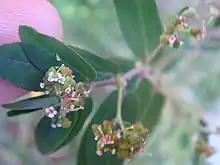Euphorbia nutans
Euphorbia nutans is a species of Euphorbia known by the common names eyebane and nodding spurge. It is native to much of the United States, Eastern Canada, Mexico, Central America, the Caribbean, and Venezuela.
| Euphorbia nutans | |
|---|---|
 | |
| Scientific classification | |
| Kingdom: | Plantae |
| Clade: | Tracheophytes |
| Clade: | Angiosperms |
| Clade: | Eudicots |
| Clade: | Rosids |
| Order: | Malpighiales |
| Family: | Euphorbiaceae |
| Genus: | Euphorbia |
| Species: | E. nutans |
| Binomial name | |
| Euphorbia nutans | |
| Synonyms[2] | |
| |
It is reportedly naturalized in parts of Europe as well as in the Middle East, Japan, and New Zealand.[2] It has also been introduced to California.[3] It can be a noxious weed in areas where it has been introduced.[4] As a weed it generally occurs on disturbed ground, or in ornamental flower beds.
Description
Euphorbia nutans is an annual herb growing erect with pairs of oblong leaves along its stems. The leaf may be up to 3.5 centimetres (1.4 in) long, hairy or hairless, and finely toothed.
The inflorescence may be solitary or borne in clusters. Each inflorescence is a cyathium, with flat white or red appendages surrounding the actual flowers. At the center of the array of appendages are several staminate flowers surrounding one pistillate flower. The latter develops into a fruit, which is a capsule about 2 millimetres (0.079 in) wide.
References
- Bárrios, S.; Copeland, A. (2021). "Euphorbia nutans". IUCN Red List of Threatened Species. 2021: e.T126568182A192153041. doi:10.2305/IUCN.UK.2021-3.RLTS.T126568182A192153041.en. Retrieved 25 November 2022.
- Kew World Checklist of Selected Plant Families
- Calflora: Euphorbia nutans
- USDA Plants Profile
External links
- Jepson Manual Treatment (TJM2) of Euphorbia nutans
- USDA Plants Profile for Chamaesyce nutans (eyebane)
- Chamaesyce nutans — UC Photos gallery
